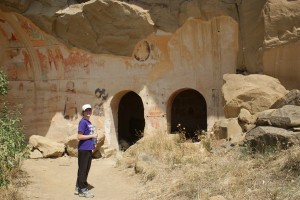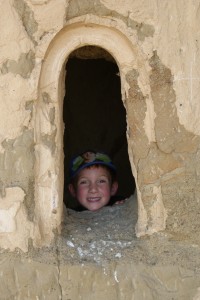From Kazbegi we made good time back to Tbilisi where we spent the night. Tbilisi was starting to feel very familiar – the supermarkets, McDonalds, the modern shops, banks – truly a world apart from rural Georgia.
Malchas met us again the following morning for our next trip – today we would be heading towards the desert monastery of Davit Gareja on the Azerbaijani border.
Georgia really does have an extraordinary geography – one day we were on the Northern border, in the high mountains, with snow-covered peaks, and the next day we were heading to the Southern border, into the desert, with blazing temperatures in the low 40’s (celsius).
Davit Gareja is a group of monasteries that have been around since the 6th century. In much the same way that early ascetics in Israel and Turkey escaped to places such as the Judean and the Syrian deserts to practise a life of meditation and silence, so too did monks in early Christian Georgia. Christians in Georgia were persecuted through the ages and Davit Gareja was no different. The monasteries were destroyed by the Mongols in the 12th Century, rebuilt and then in 1615 the Persian killed 6000 monks here in one night. The monasteries never recovered. Much more recently, the monasteries were used as target practise by Soviet artillery. Surprisingly, there is still quite a lot to see – some monasteries have been rebuilt, while ancient frescoes in caves inhabited by early ascetics survive as well. Add in the incredible desert landscape and a great hike up a mountain to see the hidden remains, and it becomes an adventurous day trip open to almost anybody. The guide books do mention that snakes are a hazard in the mountains – so despite the heat we made sure to wear long socks and jeans for protection. We didn’t see any snakes.
We arrived at about midday – not a good time to start a hike in the heat. Luckily, we had left our water oin the freezer overnight and so we had freezing cold water that lasted us a few hours. The hike was awesome – not too challenging (Eitan aged 5 managed perfectly well), and the view from the top into Azerbaijan was great. Davit Gareja is also well-known for its bird life – we don’t know much about birds, but we saw quite a few different species on top of the mountain, as well as various lizards and geckos. The ancient caves and frescoes were in reasonable shape and while it was very hot, we felt a great sense of accomplishment when we eventually made it down the mountain. There were quite a few other tourists here – since it is pretty close to Tbilisi, Davit Gareja attracts more visitors than a site like Vardzia, which is much more remote.
In almost every other country that we have visited, there would have been vendors of cold drinks and food at a site such as this – but tourism is still a relatively unknown factor in Georgia, and no-one has figured this out yet in the area of Davit Gareja, so , while we would have paid up happily for a cold Coke, there was nowhere to buy anything within about a 50km radius of the site. I should not be complaining though – the incredible thing about almost every site in Georgia is the almost total lack of commercialisation at any site that is vaguely touristic. I doubt very much that this state of affairs will continue for very long.
Eventually it was time to say goodbye to Davit Gareja – and make our way to Sighnaghi, in the middle of Georgia’s wine growing region.
PS: These days I help families plan trips to destinations on five continents. Click here for more info.


